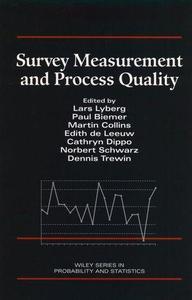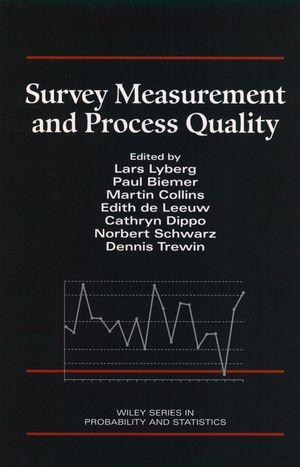Survey Measurement and Process Quality By
1997 | 784 Pages | ISBN: 047116559X | PDF | 15 MB
1997 | 784 Pages | ISBN: 047116559X | PDF | 15 MB
An in-depth look at current issues, new research findings, and interdisciplinary exchange in survey methodology and processing Survey Measurement and Process Quality extends the marriage of traditional survey issues and continuous quality improvement further than any other contemporary volume. It documents the current state of the field, reports new research findings, and promotes interdisciplinary exchange in questionnaire design, data collection, data processing, quality assessment, and effects of errors on estimation and analysis. The book's five sections discuss a broad range of issues and topics in each of five major areas, including * Questionnaire design--conceptualization, design of rating scales for effective measurement, self-administered questionnaires, and more * Data collection--new technology, interviewer effects, interview mode, children as respondents * Post-survey processing and operations--modeling of classification operations, coding based on such systems, editing, integrating processes * Quality assessment and control--total quality management, developing current best methods, service quality, quality efforts across organizations * Effects of misclassification on estimation, analysis, and interpretation--misclassification and other measurement errors, new variance estimators that account for measurement error, estimators of nonsampling error components in interview surveys Survey Measurement and Process Quality is an indispensable resource for survey practitioners and managers as well as an excellent supplemental text for undergraduate and graduate courses and special seminars.Content: Chapter 1 Questionnaire Design: The Rocky Road from Concepts to Answers (pages 27–45): Norbert SchwarzChapter 2 From Theoretical Concept to Survey Question (pages 47–69): Joop J. HoxChapter 3 Why Are There so Few Formal Measuring Instruments in Social and Political Research? (pages 71–86): Anthony Heath and Jean MartinChapter 4 Social Cognition and Responses to Survey Questions Among Culturally Diverse Populations (pages 87–113): Timothy Johnson, Diane O'Rourke, Noel Chavez, Seymour Sudman, Richard Warnecke, Loretta Lacey and John HormChapter 5 Reducing Question Order Effects: The Operation of Buffer Items (pages 115–140): Michaela Wanke and Norbert SchwarzChapter 6 Designing Rating Scales for Effective Measurement in Surveys (pages 141–164): Jon A. Krosnick and Leandre R. FabrigarChapter 7 Towards a Theory of Self?Administered Questionnaire Design (pages 165–196): Cleo R. Jenkins and Don A. DillmanChapter 8 Data Collection Methods and Survey Quality: An Overview (pages 197–220): Edith de Leeuw and Martin CollinsChapter 9 The Effect of New Data Collection Technologies on Survey Data Quality (pages 221–248): William L. Nicholls, Reginald P. Baker and Jean MartinChapter 10 Developing a Speech Recognition Application for Survey Research (pages 249–266): Bill BlythChapter 11 Evaluating Interviewer Use of CAPI Technology (pages 267–285): Mick P. Couper, Sue Ellen Hansen and Sally A. SadoskyChapter 12 The Effect of Interviewer and Respondent Behavior on Data Quality: Analysis of Interaction Coding in a Validation Study (pages 287–310): Jennifer Dykema, James M. Lepkowski and Steven BlixtChapter 13 Effects of Interview Mode on Sensitive Questions in a Fertility Survey (pages 311–329): Jared B. Jobe, William F. Pratt, Roger Tourangeau, Alison K. Baldwin and Kenneth A. RasinskiChapter 14 Children as Respondents: Methods for Improving Data Quality (pages 331–350): Jacqueline ScottChapter 15 Some Aspects of Post?Survey Processing (pages 351–370): Lars Lyberg and Daniel KasprzykChapter 16 Integrated Control Systems for Survey Processing (pages 371–392): Jelke BethlehemChapter 17 Using Expert Systems to Model and Improve Survey Classification Processes (pages 393–414): Frederick ConradChapter 18 Editing of Survey Data: How Much Is Enough? (pages 415–435): Leopold Granquist and John G. KovarChapter 19 The Quality of Occupational Coding in the United Kingdom (pages 437–453): Pamela Campanelli, Katarina Thomson, Nick Moon and Tessa StaplesChapter 20 Survey Measurement and Process Improvement: Concepts and Integration (pages 455–474): Cathryn S. DippoChapter 21 Continuous Quality Improvement in Statistical Agencies (pages 475–500): David Morganstein and David A. MarkerChapter 22 Quality Policies, Standards, Guidelines, and Recommended Practices at National Statistical Agencies (pages 501–522): Michael Colledge and Mary MarchChapter 23 Improving the Comparability of Estimates Across Business Surveys (pages 523–539): Bill Gross and Susan LinacreChapter 24 Evaluating Survey Data: Making the Transition from Pretesting to Quality Assessment (pages 541–571): James L. Esposito and Jennifer M. RothgebChapter 25 CATI Site Management in a Survey of Service Quality (pages 573–588): Mary Batcher and Fritz ScheurenChapter 26 Using Statistical Methods Applicable to Autocorrelated Processes to Analyze Survey Process Quality Data (pages 589–600): Piyasena Hapuarachchi, Mary March and Adam WronskiChapter 27 A Review of Measurement Error Effects on the Analysis of Survey Data (pages 601–632): Paul P. Biemer and Dennis TrewinChapter 28 Categorical Data Analysis and Misclassification (pages 633–670): Jouni Kuha and Chris SkinnerChapter 29 Separating Change and Measurement Error in Panel Surveys with an Application to Labor Market Data (pages 671–688): Frank van de Pol and Rolf LangeheineChapter 30 Estimating Usual Dietary Intake Distributions: Adjusting for Measurement Error and Nonnormality in 24?Hour Food Intake Data (pages 689–709): Sarah M. Nusser, Wayne A. Fuller and Patricia M. GuentherChapter 31 Identifying and Adjusting for Recall Error with Application to Fertility Surveys (pages 711–732): Thomas W. Pullum and S. Lynne StokesChapter 32 Estimators of Nonsampling Errors in Interview–Reinterview Supervised Surveys with Interpenetrated Assignments (pages 733–751): Francesca Bassi and Luigi FabbrisChapter 33 Variance Estimation Under Stratified Two?Phase Sampling with Applications to Measurement Bias (pages 753–768): J. N. K. Rao and R. R. Sitter



